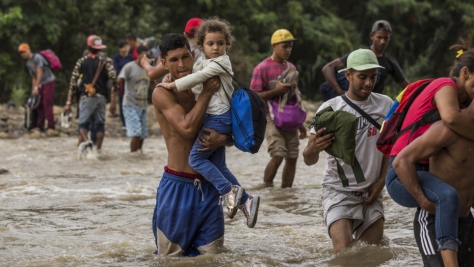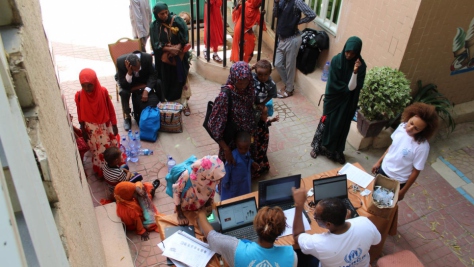Population Data
For more than seven decades, UNHCR, in collaboration with States and partners, has been collecting data on refugees, stateless people and others who have been forced to flee.
With the help of quality and timely data, we and our partners are able to make informed decisions, manage resources more effectively, inform communications and advocacy and demonstrate accountability to beneficiaries, partners and donors.
UNHCR currently generates and uses different types of data and statistics on refugees and other forced displacement, affected populations and stateless persons, such as information on:
- The humanitarian situation and the wider environment (including social, economic, political, legal and policy);
- The people affected by the situation (particularly their numbers, location and profile, including if they have any specific vulnerabilities and needs); and
- Operational information on delivery of protection and assistance of a given response to the situation.
Data Transformation Strategy
Increasingly, UNHCR’s approach to strengthening data and information systems is based on collaboration, collective efforts and joint engagement with partners and stakeholders to ensure the effective use of resources and achieve outcomes for those affected by forced displacement. As a fundamental guideline to this approach, we launched our Data Transformation Strategy, which presents a vision, strategic priorities and key actions that will be undertaken to enhance strategic and responsible use of timely, quality data and information.
Our data activities serve specific information needs, are people-centered and guided by the rights of the people we seek to serve. All processing of personal data is anchored in the UN’s Personal Data Protection and Privacy Principles and UNHCR’s Data Protection Policy.
For more information on initiatives to improve data and evidence to better assist, protect and find solutions for populations of concern, click here.
Main Statistical Publications
Global Trends
The Global Trends Report is published every year to analyze the changes in UNHCR's populations of concern and to deepen public understanding of ongoing crises
Statistical Yearbooks
Our Statistical Yearbooks follow major trends in displacement, protection and solutions
Asylum Trends
UNHCR asylum trends summarize patterns and trends in the number of individual asylum claims registered in Europe and selected non-European countries. They are available up to 2015.
UNHCR statistics technical series
The UNHCR statistics technical series is designed to make available research, developments and studies on a variety of topics relevant to the statistical work of UNHCR.
Further resources
UNHCR works with different tools and platforms to collect, analyze and process information. See below for a selection of our hubs as well as more information on figures and statistics.
Figures at a Glance
Overview of our data and statistics on who we help and our operations around the world.
Population Statistics
The Population Statistics Database provides data about UNHCR's populations of concern from 1951
Operational Data Portal
Inter-agency coordination portal showing operational information about some of the current emergencies
Resettlement Data Finder
The Resettlement Data Finder is updated monthly and provides resettlement statistics, interactive graphs and maps
WASH Dashboard
The UNHCR WASH Dashboard is an infographic database portal visualising current and historical data for the 15 UNHCR Core WASH Indicators
UNHCR Microdata Library
The UNHCR Microdata Library (MDL) provides access to microdata containing information at the individual level about UNHCR's populations of concern.
Initiatives for better data and evidence
Expert Group on Refugee and IDP statistics
An international Expert Group on Refugee and Internally Displaced Persons Statistics (EGRIS) was established at the 47th United Nations Statistical Commission (UNSC) session in 2016. This decision was based on a joint proposal by Statistics Norway, Eurostat, the Turkish Statistical Institute and UNHCR in order to improve the collection and dissemination of official refugee statistics. EGRIS consists of participants from national statistical authorities, international and regional statistical organizations and other technical experts. The role of EGRIS is to develop recommendations on statistics related to refugees, asylum-seekers and internally displaced populations.
The International Recommendations on Refugee Statistics (IRRS) were adopted in 2018 at the 49th session of the UNSC. This was an important milestone as it set a global standard for the collection, compilation, analysis and dissemination of refugee statistics. EGRIS also developed a refugee statistics compilers’ manual with operational instructions established in compliance with the IRRS.
In addition, the International Recommendations on Internally Displaced Persons Statistics were adopted at the 51st session of the UNSC in March 2020. For the first time, a comprehensive statistical framework exists for refugees and internally displaced persons.
Further information:
- Report of the Expert Group on Refugee and Internally Displaced Persons Statistics to the UN Statistical Commission at its 51st session, March 2020
- Working together for improved statistics on refugees and internally displaced persons, December 2018
- Technical report on Statistics on Internally Displaced Persons, March 2018
- Report of the International Conference on Refugee Statistics, October 2015
- Report of Statistics Norway and UNHCR on statistics on refugees and internally displaced persons, March 2015
Expert Group on Statistics on Statelessness
The Expert Group on Statistics on Statelessness (EGSS) was established with the aim of developing and adopting common standards and definitions to improve the quality and relevance of statistics on stateless populations. In December 2019, the Expert Group gathered together in Bangkok to discuss the development of International Recommendations on Statistics on Statelessness. Representatives from 16 countries, including experts from national statistical offices and line ministries, as well as UNHCR, the United Nations Population Fund and UN regional commissions participated in this meeting. The group developed an ambitious work plan to deliver the recommendations on statistics on statelessness by the end of 2020. The ultimate objective is to submit the international recommendations to the United Nations Statistical Commission for its adoption. Read more about this topic in our UNHCR blog post “Better statistics to help end statelessness”.
Inter-agency Group on Statelessness Estimates
The Inter-Agency Group on Statelessness Estimation (IGSE) has been established to update the Inter-agency estimates of statelessness in order to advance the work on monitoring progress towards the SDG’s overarching ambition that no one is left behind in the 2030 Agenda for Sustainable Development. The IGSE considers improved methodologies for analyzed and collating data on statelessness for use by agencies associated with the IGSE. A Technical Advisory Group supports this analysis through expert advice on the methodologies to be developed and applied.
Sustainable Development Goals (SDG) Indicators
UNHCR has worked with the Inter-Agency Expert Group on SDG indicators (IAEG-SDGs) to add to the indicator framework for the Sustainable Development Goals an indicator measuring the stock of refugees as a percentage of their country of origin population (indicator 10.7.4), within the 2020 Comprehensive Review. The inclusion of this additional indicator ensures refugees are granted the specific importance accorded to them for the achievement of the 2030 Agenda. Read more about this topic in our UNHCR blog post "Including forced displacement in the SDGs: a new refugee indicator."
UNHCR-World Bank Joint Data Center
The World Bank - UNHCR Joint Data Center on Forced Displacement aims to enhance the ability of stakeholders to make timely and evidence-informed decisions that can improve the lives of the forcibly displaced and their host communities. The JDC will capitalize on the synergies between UNHCR and the World Bank, complementing each other’s strengths: UNHCR in protection data, registration and collection, and the World Bank in household data, policy dialogue and analytical work. Both organizations expect to achieve efficiency and provide value to partners such as governments, the private sector, civil society, NGOs and researchers, among others.











